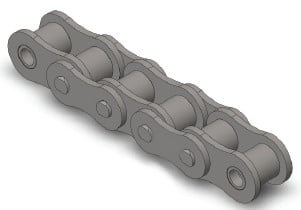Roller chains are 1 of your most productive and cost eff ective tips on how to transmit mechanical electrical power between shafts. They operate over a broad choice of speeds, manage substantial working loads, have really modest energy losses and therefore are generally economical in contrast with other methods
of transmitting electrical power. Thriving assortment involves following several comparatively easy measures involving algebraic calculation along with the use of horsepower and services component tables.
For almost any offered set of drive situations, there are a  variety of possible chain/sprocket confi gurations which will successfully operate. The designer for that reason ought to be aware of various essential variety ideas that when applied properly, help balance total drive effectiveness and value. By following the methods outlined in this part designers should be able to create selections that meet the demands of the drive and therefore are price eff ective.
variety of possible chain/sprocket confi gurations which will successfully operate. The designer for that reason ought to be aware of various essential variety ideas that when applied properly, help balance total drive effectiveness and value. By following the methods outlined in this part designers should be able to create selections that meet the demands of the drive and therefore are price eff ective.
Common Roller Chain Drive Principles
? The advised quantity of teeth for the tiny sprocket is 15. The minimal is 9 teeth – smoother operation is obtained with much more teeth.
? The suggested greatest variety of teeth for the substantial sprocket is 120. Note that though much more teeth lets for smoother operation getting also lots of teeth leads to chain jumping off the sprocket following a fairly small quantity of chain elongation as a result of dress in – That’s chains that has a incredibly substantial amount of teeth accommodate less wear ahead of the chain will no longer wrap all over them thoroughly.
? Speed ratios should be 7:one or significantly less (optimum) and not higher
than 10:one. For greater ratios the use of several chain reductions is recommended.
? The advised minimal wrap from the small sprocket is 120°.
? The suggested center distance concerning shafts is 30-50 pitches of chain. There are two exceptions to this as follows:
1. The center distance has to be higher compared to the sum in the outdoors diameters of the driver and driven sprockets to avoid interference.
two. For pace ratios higher than three:1 the center distance should not be significantly less compared to the outside diameter on the big sprocket minus the outside diameter on the compact sprocket to assure a minimal 120° wrap all around the small sprocket.